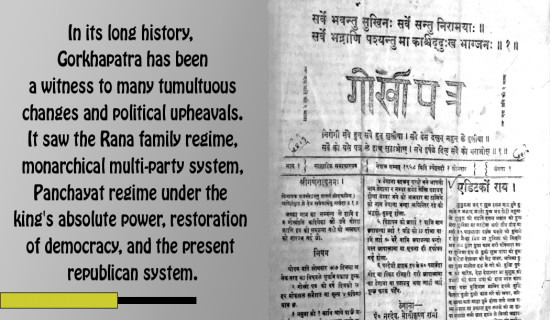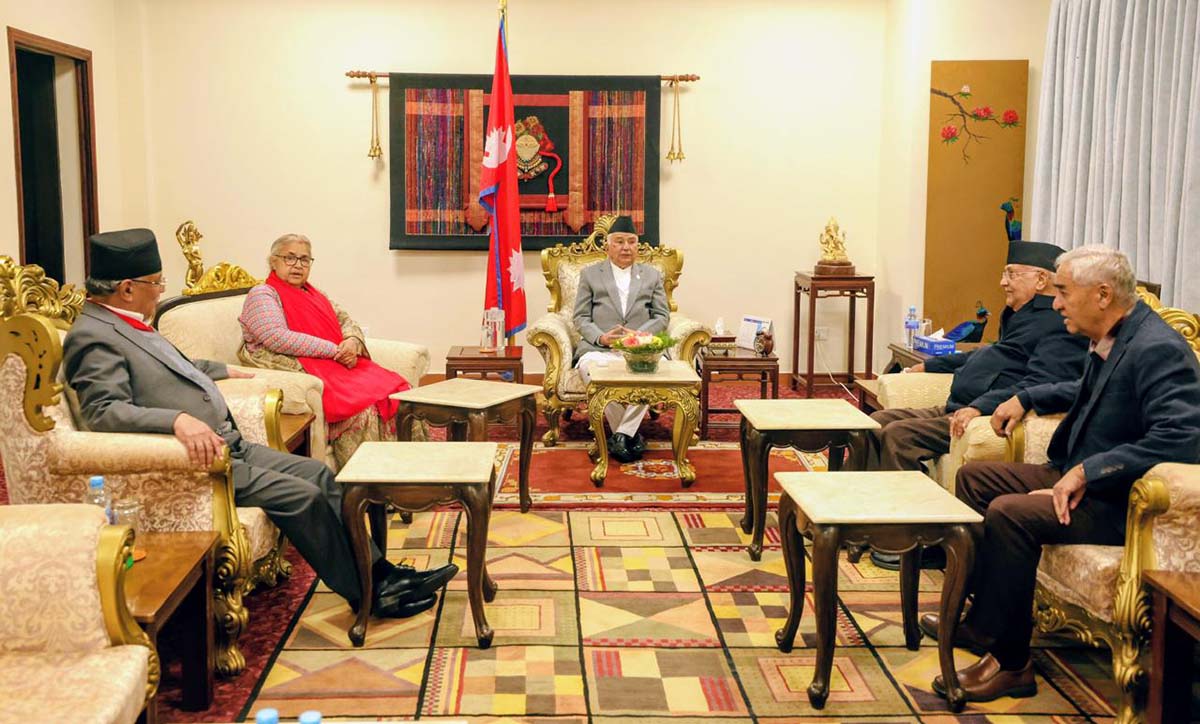- Tuesday, 23 December 2025
The Rising Nepal Is Like A Family
Journalism had never been on my wish list until the later years of college life. But circumstances led me to be a journalist with The Rising Nepal in the deca
Efficient Delivery Sustains Democratic Republic
Ever since Nepal evolved as a modern nation-state, certain days and occasions have had historic significance. May 28, 2008, was indeed a momentous day for Nepali people. On this very day, the first meeting of the Constituent Assembly made a momentous decision abolishing the 240-year-old monarchy and declaring Nepal as the world’s newest republic. Since then we have been commemorating this momentous day as Republic Day on May 28 every year with a sense of pride.
Gorkhapatra Keeps Moving Steadily
"I slip, I slide, I gloom, I glance,Among my skimming swallows;I make the netted sunbeam danceAgainst my sandy shallows.I murmur under the moon and starsIn brambly wildernesses;I linger by my shingly bars;I loiter around my cresses;And out again I curve and flowTo join the brimming river,For men may come and men may go,But I go on forever" These are excerpts from Lord Tennyson's poem 'The Brook' in which the poet beautifully portrays the life and journey of a river that begins as a small rivulet to grow bigger before joining the vast ocean. Like the poem, the Gorkhapatra had a humble beginning and grew slowly and steadily to become the proud and living history of the Nepali media industry. Writing about the Gorkhpatra is, thus, writing the history of Nepali newspapers and journalism. Gorkhapatra is a pioneer newspaper in Nepal which began in 1901. Gorkhapatra is the seed from which Nepal's journalism grew fast and steadily to become a vibrant media industry. Generally, newspapers and the media industry begin and prosper in the open and democratic ambience. The Gorkhapatra publication started when the country was reeling under the Rana family oligarchy that denied free expression and dissenting voice. Seed Of JournalismRana rulers considered education and information as an instrument that may dig a deeper grave for their demise. Even a sane person would not opt to begin a newspaper when the country's literacy rate was less than 5 per cent, let alone the number of people who could buy newspapers and read. But a reform-driven Dev Sumsher Rana took this initiative that sowed the seed of journalism and newspaper in Nepal.Jang Bahadur Rana, who began the Rana family oligarchy through what was notoriously called the Kot Massacre, visited Britain in 1850. Jung was highly impressed by the prosperity and development of Britain. He saw the tradition of British aristocrats reading newspapers during the morning breakfast. It is believed that Jung brought a hand press with him to Nepal from London, perhaps, with the idea in mind to begin a newspaper in Nepal. But it is only guesswork as it did not materialise in Jang Bahadur's lifetime. Even his successors did not show any interest as newspapers were considered inimical to the then regime. Dev Sumsher Rana, who took power after his brother Bir Sumsher Rana's death, was a reform-minded ruler. He tried to introduce some positive initiatives to bring about reforms in the country. Dev Sumsher Rana began the publication of Gorkhapatra, which was also a noble idea of that time as the literacy rate was exceptionally low. It is, perhaps, due to his reforms and liberal approach, Dev Sumsher was forced out of power by his siblings within a short period of three months. The publication of the Gorkhapatra started not in a planned way and not with much afterthought. It began with the cynicism of a ruler. As goes the hearsay, a few copies of Gorkhapatra had been printed when Britain's future King Edward VII was invited to hunting in Nepal during his visit to India in 1890. Ranas had heard that British royalties and aristocrats had the habit of reading newspapers during their breakfast. Ranas ordered to print a few copies of Gorkhapatra to show the British dignitary that Nepal also had a newspaper. But Edward did not come to Kathmandu and returned from far-western Nepal after hunting. It is not on record and has remained merely a title-tattle. Gorkhapatra has continued its publication without any interruption for over 121 years no matter how the tumultuous period and circumstances it was. There are very few newspapers in the world with such a long and continued history as Gorkhapatra has. Gorkhapatra is owned by the government, owing to which it is called the government's newspaper. But Gorkhapatra is the history and heritage of Nepal and the entire Nepali media fraternity. In its long history, Gorkhapatra has been a witness to many tumultuous changes and political upheavals. It saw the Rana family regime, monarchical multi-party system, Panchayat regime under the king's absolute power, restoration of democracy, and the present republican system. In the 122 years, many regimes have come and disappeared. Several newspapers were born and perished. But Gorkhapatra, like Tennyson's "Brook," keeps on going and continues its journey. Humble BeginningThe beginning of Gorkhapatra was, of course, humble as a weekly one. Later it came out twice a week and finally as a daily newspaper. Now Gorkhapatra has become a publishing house with some sister publications like English daily 'The Rising Nepal', monthly Literary magazine Madhuparka, Children's monthly magazine Muna and youth magazine ' Yuva Manch'. However, the question always hunts Gorkhapatra as to whom it serves. Being a government-owned newspaper, this question will always keep on striking. In response, a former editor of The Rising Nepal had once said 'The Gorkhapatra serves the people by serving the government.' After the restoration of democracy, another frequently asked question is: Should the government own and run the newspaper in a democracy? Here lies the onus for Gorkhapatra to give an answer by action and prove its worth and relevance in the days to come. (Lamsal is former editor-in-chief of TRN and former ambassador)





